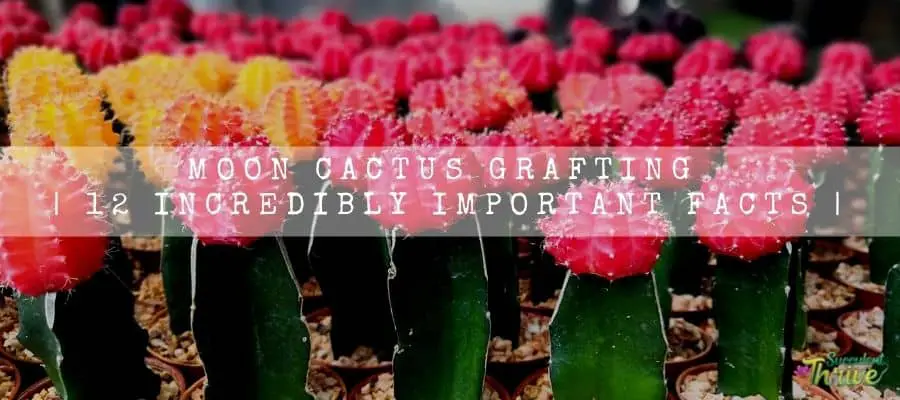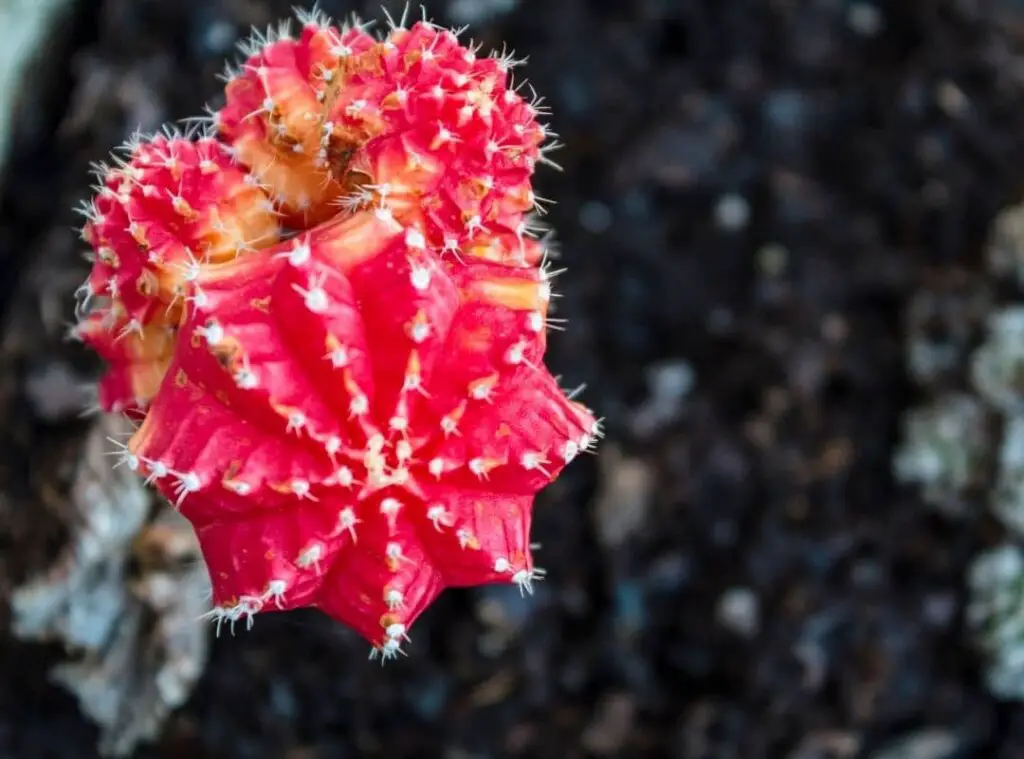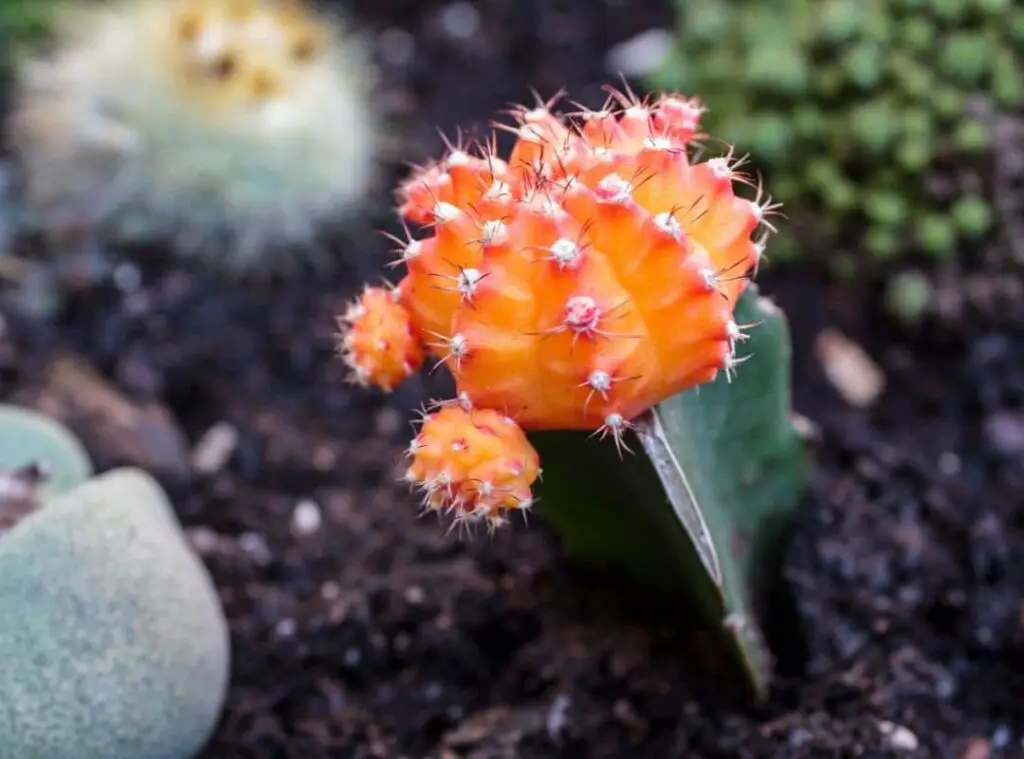Today I am going to write about the very interesting moon cactus plant and everything you need to know about moon cactus grafting.
This plant is different from every other cactus you have ever seen. To find out what, keep reading my friend.

What is moon cactus grafting?
Moon cactus is a grafted plant. It means this plant is a combination of two different plants. Upper part is made with Gymnocalycium mihanovichii.
This Gymnocalycium mihanovichii is a south african plant. In the ild they look simple and normal cactus. But their mutant variants have different colors.
The interesting thing is this mutant variant of Gymnocalycium mihanovichii does not have enough chlorophyll to survive in nature. Therefore we have to graft them to another plant with chlorophyll.
Most of the time Gymnocalycium mihanovichii grafted to hylocereus cactus.
It is essential to graft the moon cactus since they cannot photosynthesize. We are going to discuss this in detail as we proceed on.
Why do you graft a moon cactus?
The answer is to protect the plant. If you do not conduct a grafting the plant will die due to lack of food.
You all know that plants need sun or electric light to produce food and they need to have chlorophyll to do that. Unfortunately these cacti variety do not have enough chlorophyll and that is why we need to graft them.
Moon cactus has two parts; top part and root stock or base part. Normally the drifting is done to survive the top part of the plant or mutant variant of Gymnocalycium mihanovichii.
They lack chlorophyll pigments in them. Therefore they exhibit different colors. To protect Gymnocalycium mihanovichii variant from dying we graft a different plant to them such as hylocereus cactus.
Further grafting helps the vascular system to gain nutrients from the host plant and that is why the grafting is very important to keep the moon cactus to stay alive.
As aforesaid, Gymnocalycium mihanovichii alone cannot survive, and it will be a failure if you let them grow like that.
You could spot the moon cactus selling in stores already grafted. Further you could let these moon cacti live longer by re grafting it onto a fresh rootstock also.

Steps to graft a moon cactus.
Tools
You would need the following tools to graft a moon cactus.
Grafting knife – you could use these grafting knives to get clean cuts as they have specifically made up for this purpose.
If not, you may also use other knives which have the same features. However, you need to ensure that it is a clean.
Further it is important that it has a straight edge as well. More importantly it has to be a sharp one too.
Leather gardening gloves – when you arm yourself with leather gardening gloves, it would make yourself comfortable when handing them.
It would be anyway a good investment especially when you are into gardening. So grab one of those!
Rubber bands or Twine – it is crucial that you have either rubber band or twine so that you could use them and hold the two cacti together until they heal.
How to guide
There are different grafts methods which you could try. It would vary depending on the cuts you make and where you place the transplant as well.
Let us have a look at the most efficient and the easiest way of doing it. You could call this a lateral graft.
To start off with,
You need to trim the rootstock head off accordingly depending on the height you would wish to have.
Ideally, the minimum height from the soil surface should be two or three inches. Use a clean and a sharp knife to do this. When you cut it, make sure that you make a precise cut.
Secondly, when you finish cutting the rootstock, you need to cut the head off from the host cactus to create the scion.
Moreover, make sure that scion and the rootstock are even in the diameter when they stick together.
Next, take a look at the sliced part of your cacti, chances are that you could spot a ring or maybe some dots which resemble tubes on it. They are xylem and phloem.
They usually occupy the plant’s vascular system. It is up to the plant tissues to produce new xylem.
They are literally like the blood vessels of the plant. So, you need to make sure that you match these to the best possible level you could.
You could call this the make or break part of the grafting process. Consider that you have a precise cut, and you were able to match the sides, then you have done it properly. .
Fourthly, you need to place rubber bands or twine and that will make sure that plant is tied up together. You need to put rubber bands or twine covering the whole plant.
In other words, you need to place them from the top of the cactus to down and even around the pot also.
Don’t worry as it will not cause any damage to the plant. If you wish you may also, use a skewer like a sandwich toothpick to hold them together.
You are almost done. I guess it is not too much work! Give it about two months’ time and you will see how permanently those two cacti have bonded together.
They are not two cacti anymore. When you think it is completely healed, you could resume watering them and start caring for it like you used to do before. Isn’t that easy and so much fun to do?
What is moon cactus grafted to?
It is important that you graft the moon cactus so that they can thrive well. unless, since it would not be possible for them to produce energy due to the lack of chlorophyll they have.
They could be useful only as scions which would be the top part of the cactus.
Hence why you need to graft it with a rootstock such as Hylocereus which is commonly called as dragon fruit.
The host cactus is what provides all nutrients for the top part of the cactus to thrive. Ultimately, they would reward you with a pleasing plant.

Can you graft moon cactus to any cactus?
Yes they can graft to another cactus. For example, Cereus peruvianus, Hylocereus trigonus, or Trichocereus spachianus.
Can moon cactus grow without grafting?
They cannot grow without grafting. It is not possible for the moon cactus to grow without grafting.
How long does it take to graft moon cactus?
It will not take too long to conduct this process. However it would take about two months’ time to complete the graft.
What is the best rootstock for Moon cactus?
- Hylocereus trigonus or undatus.
- Cereus peruvianus.
- Trichocereus spachianus.
It is important to note that, if you select the same species for both rootstock and for scion, there would be an excellent compatibility.
If you use two plants in the same genus, they could graft. On the other hand, it is very rare to use two plants which are in the same family.
Furthermore, keep in mind that you always have to go ahead with two cacti only.
Is grafted cactus poisonous to cats?
Grafted moon cactus is not poisonous for cats.
Can you plant Moon Cactus babies?
Yes, you could plant the moon cactus babies. To do this, you simply have to trim them off and place them in a well-draining sandy soil mix.
Water them once you spot them rooting. However, there will be a long wait as it could take about 6 months to root them.
What is moon cactus re-grafting?
You need to re-graft a moon cactus simply because you cannot use the propagation process for them.
Whenever you spot that the upper part of the moon cactus tends to separate from the rootstock cactus you need to re-graft them. It would help to keep your cacti healthy.
How to do a moon cactus re grafting?
To do this,
First, sterilize the knives and trim the upper part of the cactus. Then cut the upper part of the green stock.
Observe both cacti parts xylem and phloem and place both these together whilst lining up the two vascular circles.
Place rubber bands over the cactus and around the pot as well. when it is a few weeks’ time, you would see the fusing of it and how they have transformed into an individual plant.
Read Next Moon Cactus Soil, Pot, And Repotting | 6 Exciting Facts |
Read Next Moon Cactus Size | 4 Problems Everyone Has About Them |
